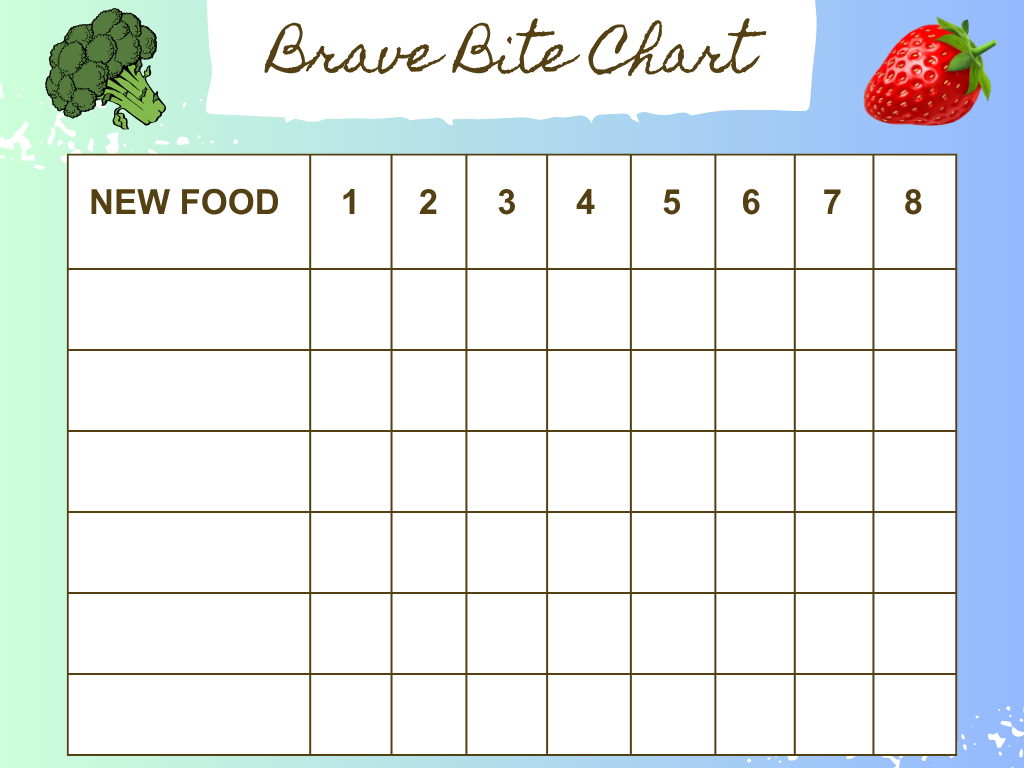Conquer Mealtime Battles with Our Free Picky Eater Chart: Download the Brave Bite Chart Today!

Are mealtimes turning into battles in your home? If you’re constantly negotiating with your child to try a single bite of broccoli or pleading with them to sit at the table for five minutes, you’re not alone. Many parents face daily struggles with picky eating, and the stress can take a toll on the whole family. But there’s hope. With the right tools, such as a Picky Eater Chart, you can transform mealtime into a positive, engaging experience. And we’ve made it easy with our Brave Bite Chart—a fun, effective, and free resource you can download today.
What is a Picky Eater Chart?
A Picky Eater Chart is a visual and motivational tool designed to help children try new foods and build healthier eating habits. These charts work by encouraging exploration, reducing anxiety around new foods, and rewarding effort over perfection. Instead of forcing or bribing kids to eat, these charts use positive reinforcement to gradually broaden their food preferences.
Using a picky eater chart turns mealtime into a game instead of a power struggle. Children can track their progress, earn stickers or stars, and feel a sense of accomplishment for trying something new—even if it’s just a single brave bite.
Why Do Kids Become Picky Eaters?
Picky eating is common in early childhood, especially between ages 2 and 6. It’s often a normal part of development as children assert independence and test boundaries. But for some kids, picky eating can become a long-term challenge, especially if anxiety, sensory sensitivities, or routine disruptions are involved.
Common causes of picky eating include:
- Fear of new foods (neophobia) – This is especially common in toddlers who are learning to establish their likes and dislikes.
- Sensory sensitivities – Some children are more sensitive to textures, smells, and temperatures, making new foods overwhelming.
- Power struggles – Mealtimes can become battlegrounds when children feel forced to eat.
- Routine-based habits – Kids often prefer familiar, repetitive foods and resist change.
To learn more about why your child may be demonstrating picky eating, click the link above.
A Picky Eater Chart like the Brave Bite Chart gives children a sense of control while gently nudging them toward healthier, more varied eating habits.
Introducing the Brave Bite Chart
Our Brave Bite Chart is a unique picky eater chart specifically designed to support children who are hesitant about food. It encourages kids to take “brave bites”—small, manageable tastes of new or challenging foods. The idea isn’t to clean the plate, but to try a bite and celebrate the courage it takes to try something unfamiliar.
Here’s what makes the Brave Bite Chart special:
- Fun and colorful design that appeals to young children
- Clear structure with space to record brave bites each day
- Positive reinforcement through sticker spaces or reward boxes
- Goal setting so kids can work toward a prize or privilege
- Downloadable and printable—completely free for parents and caregivers
How to Use the Brave Bite Chart Effectively
- Introduce it positively: Frame the chart as a fun game or challenge. Let your child pick the stickers or markers they’ll use.
- Start small: Choose just one new food a day—or even per week—to focus on. A "brave bite" is just that: a bite. If your child won't even attempt to bite a new piece of food. Start with just having them touch the food, smell the food and then touch the tip of their tongue to a new food. These are all incremental steps leading to the first bite.
- Celebrate effort: Even if your child doesn’t swallow the food, giving it a sniff, lick, or tiny nibble is progress.
- Use rewards wisely: Non-food rewards like an extra bedtime story, choosing the next family movie, or earning a special toy can motivate kids without turning food into a bribe.
- Stay consistent and patient: Habits take time. Keep using the chart consistently, and you’ll likely see progress.
I highly recommend incorporating the animated video below that uses video modeling for kids to try new foods! Have them watch it regularly prior to trying new foods as part of a routine.
Benefits of Using a Picky Eater Chart
Parents who incorporate charts like the Brave Bite Chart often notice these improvements:
- Less mealtime stress and more cooperation
- Increased willingness to try new foods
- Improved family dynamics and reduced tension
- Enhanced self-esteem in children for trying something brave
- Opportunities for positive reinforcement and bonding
These tools don’t just help with food—they teach resilience, flexibility, and open-mindedness in other areas of life too.
Free Brave Bite Chart – Download Now!
We’ve made it incredibly simple to get started. Our Brave Bite Chart is completely free to download. It’s designed for busy parents, teachers, and therapists who want a quick, ready-to-use solution for picky eating.
Whether you’re at home, in a daycare setting, or working in a pediatric therapy practice, this tool fits right into your routine.
Final Thoughts: Empower Your Child with Every Bite
Picky eating doesn’t have to dominate your dinner table. With a supportive, playful approach and tools like our Picky Eater Chart, you can help your child expand their palate at their own pace. The Brave Bite Chart gives them a way to track their bravery and feel proud of even the smallest steps forward.
Don’t wait to start building healthier habits and happier meals—
🎉 Download your Brave Bite Chart now and make picky eating a thing of the past! 🎉
If you haven't already, be sure to check out my ebooks, now on Amazon!


